The problem of developing a good sausage plant layout is relatively complex, however small the plant may be. First of all, it would be inadvisable, and even impossible, to adapt a uniform approach in all countries or regions because of the geophysical, economical and social differences and variations in livestock, the meat trade, customs and food habits etc. It is always indispensable to make a careful survey of the existing livestock and meat supply conditions before any sausage plant construction or remodelling is proposed. The attitude and outlook of livestock and the meat trade, especially in the less developed regions, must be seriously taken into account. A hindrance to progress may be the bad habits and unhygienic meat handling practices in the local slaughterhouse which intends providing the meats for the sausage plant. The food habits and flavour preferences of the local meat consuming public should also be investigated.
In this chapter technical details are given as well as a description of the underlying principles for sausage plants which may assist those planning new plants or remodelling old ones in consultation with architects to select the most suitable solution for local conditions. Simplicity of design and costs are of particular importance for small sausage plants. These suggestions have been outlined merely as a guide and they may require modification to suit particular conditions. Because of variations in requirements, a standard blueprint cannot be produced. Only occasionally the standard type sausage plant would be directly applicable to a particular situation. In the majority of cases the design must be considerably modified to meet the local peculiarities of the site selected for the plant, its environment, local handling and transport practices and human and material resources. The local health and veterinary authorities, where they exist, must be consulted before a final decision is taken.
Whenever the construction of a new sausage plant or the remodelling of an old one is envisaged, a plan to overcome possible defects is recommended. It is of paramount importance to draw up a plan giving the greatest efficiency to the entire sausage plant. It is essential to follow a system in planning and designing even if the plant will initially have a small throughput. The remodelling of an old and obsolete plant often requires more compromises than does the design of a new layout.
Economic and marketing considerations are vitally important in determining the most suitable location for a sausage manufacturing plant. The first and the most important consideration is the meat supply, followed by the distribution of sausage products to consumers. The discrepancies between the retail price paid to farmers for live animals and the price for locally sold sausages, which should be determined on the basis of commercial research, are essential factors for choosing a specific geographical area to locate a sausage plant. Rather than build a sausage plant large enough to deal with the periodic sausage marketing peaks, it is considered advisable to base the size on average daily requirements and to extend hours of processing during peak periods.
The site of a sausage plant within a distinct area should be selected on the basis of certain factors. Where legislative measures do not exist, there are certain considerations which must be observed. The sausage plant should be located in an area free from objectionable odours, smoke, dust etc. and should be completely separated from any other plant or building. No communication by doors or windows is permissible. Attention should be given to an adequate potable water supply, arrangement for drainage and adequate electric power sources. In planning a sausage plant, consideration must be given to a location or an arrangement of buildings that will permit future expansion.
The traditional location of a sausage plant close to the slaughterhouse is still advantageous since the problems of professional workers and fresh meat and by-product supply are markedly simplified. However, if the sausage plant is well managed, it will do its share of business regardless of whether it is located near to or far from a slaughterhouse. Although it is not customary to have a small sausage factory as an integral part of a small slaughterhouse, occasionally such a situation does occur, either in a private or cooperative form.
In general, the space of a sausage plant must be compact and designed for economical throughput in relation to the capital and operating costs. The whole structure must suit local climatic conditions. Brick, stone, reinforced concrete, and prefabricated steel structures are the most widely used building materials. Although in the tropics it may be cheap and often immune to parasites, wood is not a satisfactory material for use in a sausage plant.
A non-slip, hard, smooth and impervious floor, that will not absorb moisture and can be readily cleaned, is indispensable. It should be of the best lasting quality. Sharp corners, joining the walls and floor should be avoided. The surfaces of interior walls must be impervious and smooth and made of non-absorbent materials. Walls should be covered and coated with lead-free paint or tiled at least to a height of 1.8 m.
Ceiling surfaces of rooms, where wet operations are conducted, should be smooth and flat and of sufficient height. Natural ventilation is always preferred but very often artificial ventilation is the only solution.
The slop (usually of 1.8–2.0 percent) of floors to drainage inlets must enable rapid disposal of effluent. All effluent drainage lines must have a sufficient inside diameter of at least 10 cm with the fat traps incorporated in the drainage system. Drainage lines from toilets and urinals should be constructed as a separate system.
The method of sewage disposal should be under the local health authorities' control.
A well-designed sausage plant cannot be attained through buildings alone. Sanitation is also essential in a well-run sausage producing plant. The hygienic maintenance of equipment and the plant as a whole is a cardinal factor for production efficiency and keeping quality of finished products. Tile walls, hard-surfaced brick or concrete floors, carefully sloped to drains, stainless steel table tops, galvanized metal trucks, barrels and pans are an integral part of a good sanitation programme. Briefly, strict sanitary methods and conditions must be employed through the entire process.
Provisions should be made for elimination or removal of any vapour which would cause condensatipon on walls and ceilings. A sausage producing plant must be provided with suitable facilities for collection and disposal of bones, ligaments and other offals, and for such wastes as paper etc. Waste containers for bones, inedible fats etc. are needed, especially in the processing area. Lavatories and other washing and shower facilities should be provided for workers of both sexes, supplied with hot and cold water and maintained in a clean condition. Consideration should be given to the incorporation of a small laundry in the sausage plant and also to the provision of changing rooms and eating rooms for employees.
Cabinets must be provided for efficient cleaning and sterilization of trucks and other movable equipment. Equipment is placed in the cabinets and then sprayed with cleansing solutions, and finally rinsed with clean hot water. Stationary equipment, such as cutters etc., should be carefully cleaned individually, and after that, disinfected and dried. Every possible precaution should be taken to keep the plant free of flies, rats and mice. Screens for outer openings that do not admit entry of files are often useful. Adequate arrangements should exist for effluent disposal.
The governing principle in daily routine cleaning in any sausage plant is the scrupulous cleaning of all contaminated places and surfaces. Brushing and flushing with water under pressure should be the most used method of cleaning. The cutting and trimming section requires exceptionally careful attention.
Steam or hot water is required to remove grease adhering to the surfaces of tables and machines. Detergents contribute considerably in cleaning because they emulsify fat and dissolve proteins. It is of primary importance that disinfection of the sausage plant is done in connection with general and thorough cleaning. The regular repair of walls, floors and equipment is also an important part of plant sanitation.
Fly control is a basic sanitary step for any sausage manufacturing plant located in a warm climatic region. Although the main objective of fly control is the elimination of conditions encouraging fly development, fly proofing of the sausage plant is strongly recommended. Ants, mosquitoes and other insects, as well as birds, may also be a problem in the tropics against which the sausage plant should adequately protected.
While sausage plant layouts vary widely according to the diversity and volume of products, certain well-defined principles are always respected in present-day plants. Anywhere where space permits, product movement should follow a straight line pattern, from the receipt of raw material and its storage through trimming, mincing, emulsifying, filling, smoking and cooking operations to the packaging, storage and distribution of the finished product. The main technological and hygienic principles in developing sausage plant layout are the maximum speed in handling raw materials aand products and the shortest time intervals between operations resulting in the shortest possible distances consistent with the size and type of the plant.
There are some common requirements determining the layout of a sausage plant. Doubtlessly, the basic requirement is that the raw materials should enter at one end of the building and the sausage products, either chilled or unchilled, leave at the opposite end. The arrangement should be that the meat and products move in one direction without any risk of contamination. The operators are placed along the tables and machines and they move the raw materials and sausages in the necessary direction.
Normally, a sausage plant begins with a receiving and chilling section. When the meats reach the plant by truck, provision has to be made for an offloading ramp. There should be a direct and unobstructed entrance from the receiving area to the chillroom and main processing room. The operation of receipt, weighing and storage of meats should be carried out in a refrigerated room adjacent to the main workroom. Where output permits, nonmeat raw materials (casings, spices, packaging materials etc.) should be dealt with separately in order to ensure a good hygienic standard.
Effort should be made to provide refrigeration in the cutting and trimming room. The deboning and trimming operations should be performed on special tables in a clean and controlled atmosphere. The deboning of hot carcasses should have priority.
All grinding, chopping, stuffing, linking and other processing operations have to be organized in a separate room. The type and extent of equipment required for comminuting meat and stuffing sausages depend upon the variety and volume of the operations. For operations of any magnitude, equipment such as an ice crusher or ice generator, knife grinder, frozen meat slicer etc. is advisable.
The meat, after being trimmed, graded, chopped and mixed with nonmeat ingredients, is conveyed from the cutter to the stuffer for filling into casings and then the sausages, hung on smoke rods, are carried from the meat chopping and mixing area to the smoking and cooking facilities. Any sausage manufacturing line terminates in the smokehouse and cooker, where the necessary trucks, cages and other accessories are available. The size of the smokehouse and boiler will depend upon the factory throughput. Adequate provisions should be made even in the smallest plant for weighing, grading, storing and distribution of final products.
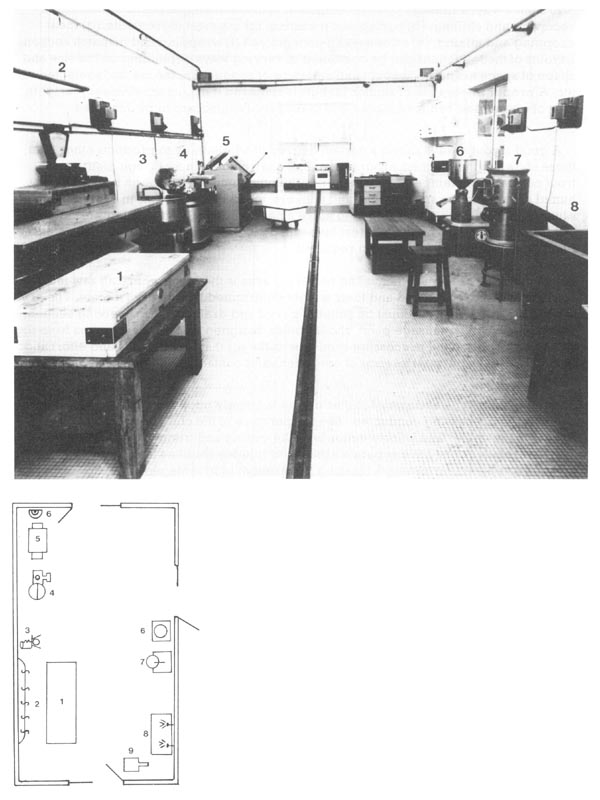
Fig. 2 MEAT PROCESSING ROOM, Institute of Food Technology, Dakar, Senegal
Cutting and trimming area:
1 - working table, 2 - overhead rail:
Chopping and mixing area:
3 - mixer, 4 - grinder and cutter,
5 - vacuum mixer, 6 - steam sterilizer,
7 - colloid mill, 8 - washing vat.
In such a way, a sausage plant is composed of the following areas or section: (a) receiving and chilling, (b) cutting and trimming, (c) nonmeat ingredients, (d) meat chopping and mixing, (e) smoking and cooking and (f) wrapping and dispatch sections. Layouts of these sections can be combined in varying ways depending on the size and shape of space available, amount and structure of production, the methods selected etc. A proper integration of section layouts is required if maximum efficiency, smooth flow of operations, reduced labour and managerial control are to be achieved.
A good layout always shows a certain degree of adaptability to products other than those shown in the planned programme. The environment in a sausage plant varies from normal room temperature and normal relative humidity, through hot and highly humid air around the smokehouse and cookers, to cold saturated air in chillers. The sausage manufacturers who intend to make a new or remodel an existing sausage plant should contact the Government Meat Inspection Service and furnish drawings of the plant layout and other information required.
The receiving area is the place where all raw materials which arrive are checked and their weight determined by means of a scale. The area around the entrance door must be suitably paved and drained. The receiving section, even in the smallest sausage plant, should be so designed that the meat moves from the receiving door into the processing section with the least amount of time and effort and without any possible interference of operations and contact of the meat with other raw materials.
The selection of type and size of chiller depends largely upon the capacity and character of processing conducted. The temperature of the chiller should be 0° to 4°C. Access to the chiller and its connection with the cutting and trimming area must be easy. The chiller must have separate areas with suitable facilities for holding by-products and meat curing; a freezing department is advantageous.
This section, adjacent to the chopping and stuffing area, includes the space occupied by cutting and trimming tables; there should be sufficient room for free movement and safe use of knives, cleavers and other tools. A room temperature of 13°C is considered good practice. The humidity should be low enough to give a dew point close to that of the surface temperature of the product.
This section needs a separate, dry and cool area, protected from insects and humidity and provided with tables, scales and other facilities for storage, control and preparation of spices, casings, containers etc.
This section includes the space in which the meat is processed, mixed with other ingredients and stuffed into casings. This section is occupied by basic processing equipment such as a grinder, cutter, mixer, stuffer and working tables. It is extremely important that all equipment is designed for easy cleaning.
The layout of the section deserves particular attention. Each item of equipment should be located to permit easy access to the operator.
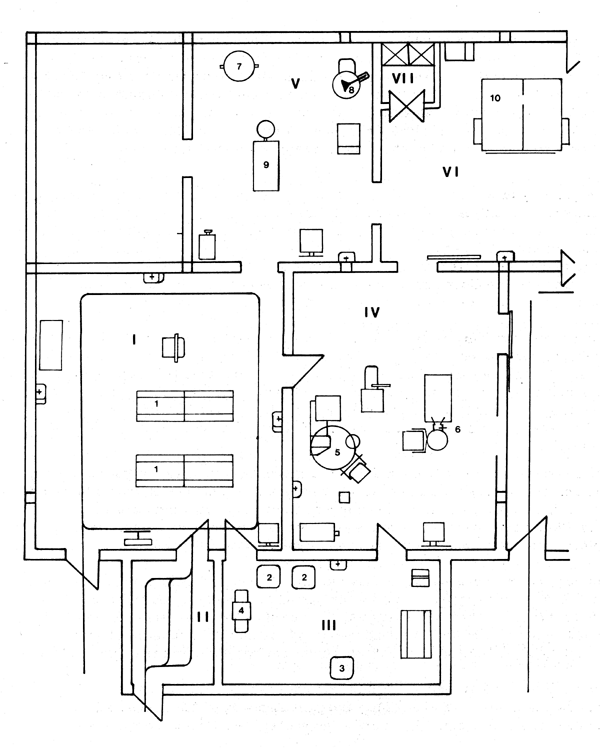
Fig. 3
SMALL-SCALE SAUSAGE MANUFACTURING PLANT IN BECEJ, YUGOSLAVIA
Courtesy of Prof.Dr R. Rede, Food Technology Institute, Novi Sad, Yugoslavia)
I - Cutting and trimming section, II - Chilling section, III - Meat curing section,
IV - Chopping and stuffing section, V - Cooking section and chopping and stuffing cooked sausages,
VI - Smoking section, VII - Equipment sanitation area.
1 - Trimming table, 2 - Curing vat, 3 - Massager, 4 - Pickle injector, 5 - Cutter, 6 - Stuffer,
7 - Cooker, 8 - Cutter, 9 - Working table, 10- Smokehouse.
The principles, applicable to the layout of this section, are:
the smokehouse should be built so that its fireplace opens externally; good air and smoke circulation in the smokehouse is essential and a thermometer for checking the temperature is highly desirable,
the smoking and cooking section should be well isolated from other areas; adequate ventilation is an important prerequisite.
The type and size of this section are determined not only by the number and structure of finished products but mainly by the method of marketing. This section may be located in an outside main building. In smaller plants some wrapping operations may be done in another section at the end of the work-day. Special attention should be devoted to the arrangement of an adequate storage area.
Selection of the proper type of sausage producing equipment involves the consideration of a number of factors, such as type and volume of production programme, labour, speed of production desired, ability to vary quickly the type of sausage, price of raw materials, cost of maintenance etc. A proper sequence of operations and a wise choice of equipment can considerably aid the economical and successful flow of operations and avoid bottlenecks impeding the process. Great care should be given to the choice and placing of machines and other equipment in such positions that not only will one be capable of performing the most effective work but also of moving raw materials and productds from one operation to another with minimum contamination. Adequate importance must be given to each separate item of equipment bearing in mind that too large a machine is an unnecessary expense but, a machine which is too small, is a permanent handicap.
Special points to consider in the selection of any equipment are:
appropriate material to minimize corrosion,
robust construction in order to minimize maintenance,
satisfactory design to enable handling and processing of meat and other raw materials and to facilitate thorough cleaning,
capacity to meet requirements.
All equipment should be provided with the necessary safeguards so that its operation will not be hazardous.
The meat grinder is a sausage making tool that forces meat scraps under high pressure along a horizontally mounted cylinder with sharp-edged ribs through a series of holes in a perforated plate. As the compressed meat extrudes through the holes in the plate, a revolving four-bladed knife cuts it. The perforated plate has round holes ranging from 1 to 13 mm. The degree of comminution is most of all determined by the choice of the hole diameter in the perforated plates.
Table grinders usually have 70 to 98 mm cylinders with the finest plate being 1 mm. The cylinder diameter of a large industrial grinder can reach up to 300 mm. Grinders are usually employed as the first step in the comminution of meat.

Fig. 4WORM OF FEED SCREW OF A GRINDER
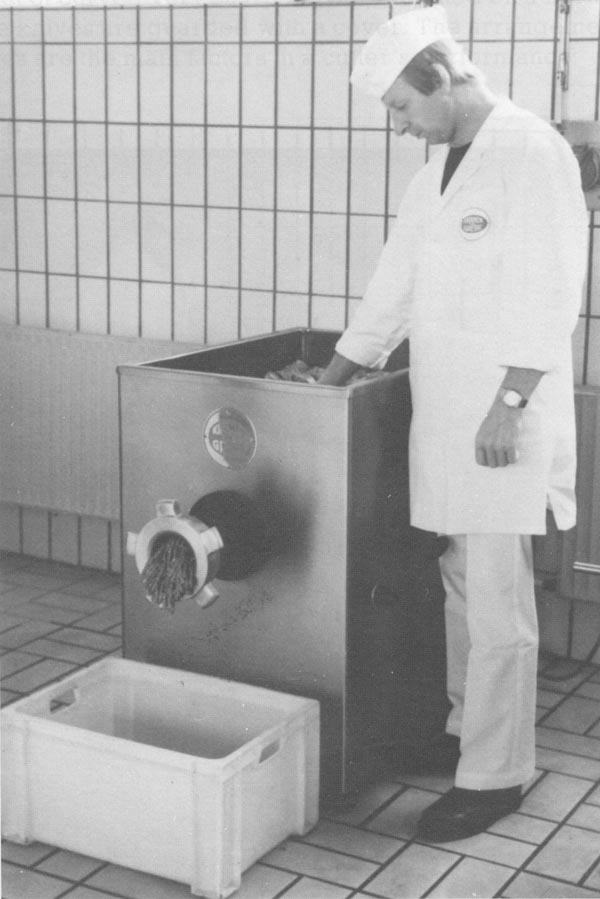
Fig. 5 ELECTRICAL GRINDER (Electrowolf 114 mm)
The machine is equipped with a worm or screw feed and hand operated
(Photo courtesy of Kraemer und Grebe, GmbH & Co KG,
D-3560 Biedenkopf-Wallau, W.Germany)
The grinder should never run empty as this ruins the knives and plate. Frozen meat or meat rich in connective tissue is grinded first through a coarse plate and then through a fine plate. All parts of the grinder coming into contact with the meats are made from corrosion-free materials.
Mixers are primarily used in obtaining a well blended mix of ground meat, fat and spices for coarse-ground sausages. Mixing under a partial vacuum has some advantages, especially in the preparation of dried sausages. The machine generally consists of arectangular round-bottom vessel through which run two parallel shafts equipped with wing-shaped paddles agitating the meat mass back and forth to give a uniform distribution of fat and lean particles, spices and other ingredients. Discharge is usually by tilting the mixer 90 degrees. Overloading the mixer prevents good mixing.
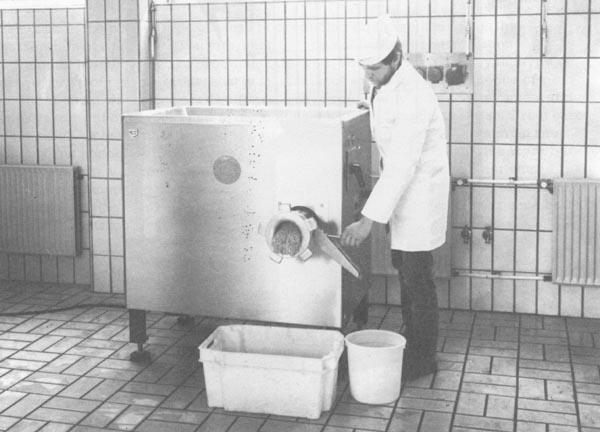
Fig. 6 GRINDER (Winkelwolf 130 mm) EQUIPPED WITH A DEVICE FOR SEPARATING
THE CARTILAGE, TENDONS AND BONE PARTICLES FROM MUSCLE TISSUE
(Photo courtesy of Kraemer und Grebe, GmbH & Co KG,
D-3560 Biedenkopf-Wallau, W.Germany)
Various machine tumbling or massaging systems are available. Different types of these machines differ greatly in their efficiency. A non-expensive tumbler which comes up to the requirements of each small-scale sausage manufacturer has been developed from the concrete-mixer. In the most expensive tumblers the meat is tumbled in regular time intervals.
Cutters are designed to comminute meat materials very finely by revolving them in a bowl with rapidly rotating knives.
The cutter is today the most frequently used meat-chopping machine. There are many cutter types and sizes and it is not always easy to select a cutter having the right capacity and highest efficiency for a given product. Cutters, commonly found in meat processing plants, are essentially composed of a horizontally revolving metal bowl equipped with a set of curved very sharp knives, mounted on a horizontal axle rotating at high speed. The knives are guarded with a cover. The arrangement, number, shape and speed of knives are the main factors in a cutter's performance.
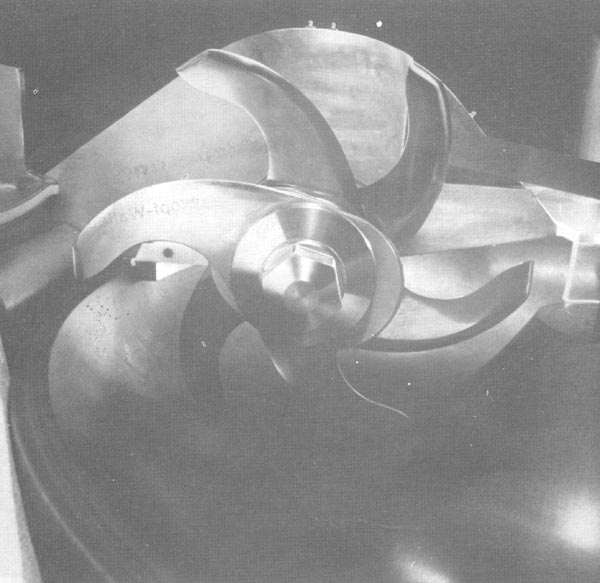
Fig. 7 HIGH-SPEED KNIVES IN A STANDARD CUTTER
(Photo courtesy of Kraemer und Grebe, GmbH & Co KG,
D-3560 Biedenkopf-Wallau, W. Germany)
Modern cutters usually have dual-speed knives and a variable bowl speed; they are often equipped with a special device for emptying the bowl as well as a thermometer over the bowl to help in controlling meat temperature during chopping. They can operate under vacuum which contributes to a better colour and improves the water binding capacity of the meat.
Quite small cutters usually have a 15 to 30 litre bowl with two speeds of bowl rotation and knives rotating at 1000 to 2000 per minute. Such cutters can be operated by 12-15 HP motors. Cutters for small-scale sausage manufacturers have 25 to 50 litre bowls with a variable bowl speed and knives rotating at 1500 to 3000 per minute. Some machine manufacturers supply cutters with knives rotating at 4000 to 5000 rpm. Cutter power requirements are high: a cutter with a bowl capacity of 200 to 250 kg needs a 75 HP main motor and a 3 HP auxiliary one.
The knives should be maintained in a thoroughly sharp condition; periodically they need a superficial finish with a fine stone. The cutter knives should be adjusted to the bowl at a distance of 0.7 mm.
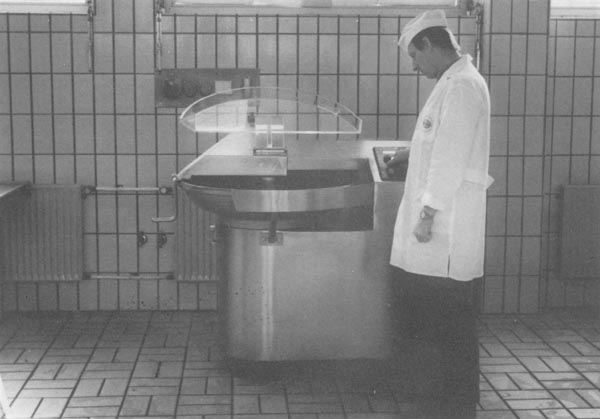
Fig. 8 STAINLESS STEEL CUTTER EQUIPPED WITH A PROTECTION COVER.
Bowl capacities of 45, 65, 90 and 120 litres
(Photo courtesy of Kraemer und Grebe, GmbH & Co KG,
D-3560 Biedenkopf-Wallau, W. Germany)
A combined machine, consisting of bowl cutter and grinder, often fits the work requirements in a small-scale sausage plant. Most of the larger and faster cutters are now equipped with devices which enable easy loading and emptying of the bowl.
In recent years, new equipment such as an emulsifying mill has been designed for preparing meat emulsion. The emulsifying mill has proved itself in the meat processing industry all over the world. It usually includes a perforated plate on which a two-edged blade rotates, i.e. cutting knife or knife rotor. Immediately below the plate is a centrifugal pump that forces material through the perforated plate. At present emulsifying mills are constructed with many cutting combinations, in either vertical or horizontal units. One design of these machines has a cutting action of two corrugated face plates: the outside rotating at 2000 to 2500 rpm (coarse chopping) and the inside, which is stationary, regulating the particle size of the meat (fine chopping).
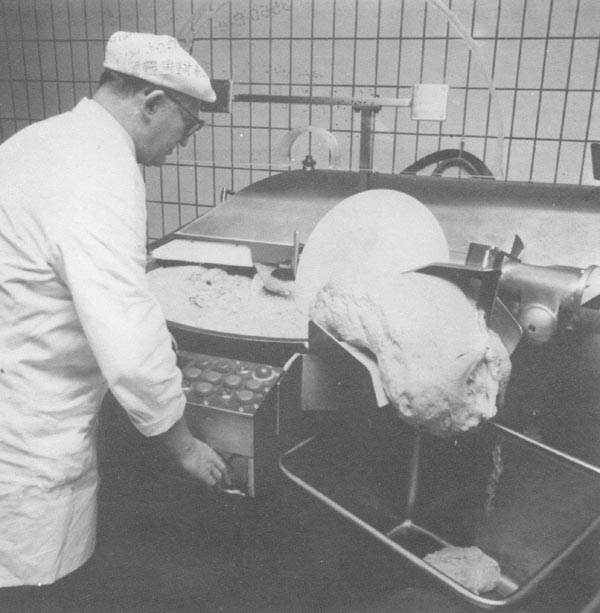
Fig. 9 THE CUTTER EQUIPPED WITH DEVICE FOR EMPTYING IT
WITHOUT THE USE OF THE HAND
(Photo courtesy of Kraemer und Grebe, GmbH & Co KG,
D-3560 Biedenkopf-Wallau, W. Germany)
Compared to the cutter, the emulsifying mill operates at a much higher speed, producing a finer emulsion. Normally, the emulsion is ready for stuffing by one passage through the machine.
The most common machines for cutting frozen meats are guillotines and rotating cutting machines.
Guillotines are relatively simple, not too expensive space-saving cutting devices that can be adjusted to give different thicknesses of meat cuts. A distinction should be made between guillotines with a horizontal working table (cutting blades move in an up-and-down direction) and those with a vertical cutting knife (cutting blades move in a sideways direction). Fully automatic guillotines have been developed for large-scale sausage plants.
Machines operating on the blade-rotating principle are cutters, flakers and dicing machines. Cutters can produce a desired uniform size reduction of the frozen raw material (meat or fat) without smearing it. Flakers are equipped with beak-shaped cutting blades to chip or peel off the frozen meat block into flakes. The dicing machines are used in the manufacture of cooked sausages for giving a dice-or disc-shaped form to different raw materials.
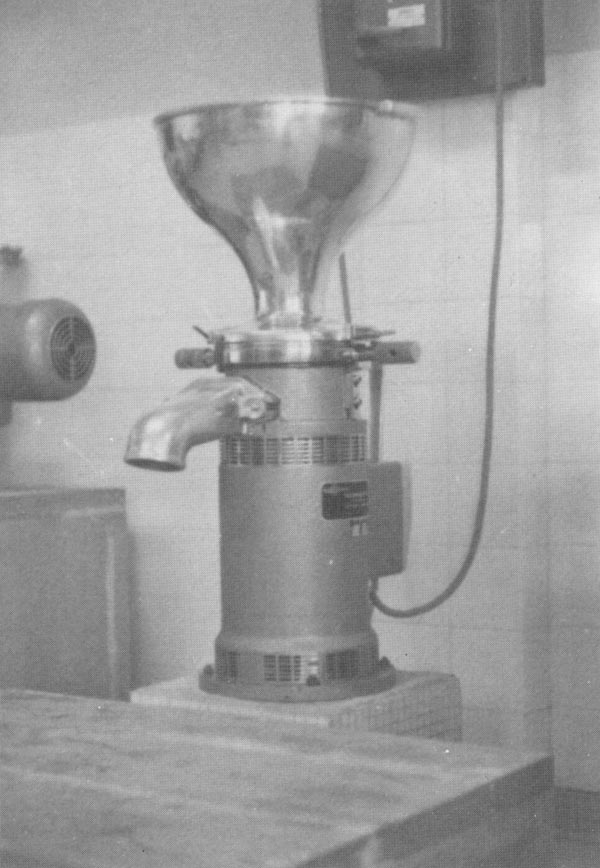
Fig. 10 EMULSIFIER IS A MACHINE COMBINING THE PRINCIPLES OF GRINDING AND CHOPPING
There are two well-known and proved systems used for stuffing of the emulsion in casings or in other containers. First, the common or piston filling machine, or simply, a stuffer which is a compressed air-driven or hydraulic or manually operated machine. The vertical piston stuffers are popular among small-scale sausage manufacturers. They are recommended for coarse-ground sausages but they are also useful for fine emulsion stuffing. The pump stuffers, working often on a continuous basis, are preferred by large-scale sausage manufacturers.
The piston stuffer is a cylinder, equipped with an easily movable cover and a piston moving upward pushing the mix into the casing through a stuffing tube or horn of suitable size. The larger the diameter of the stuffing horn, the lesser will be the smearing of the mix. Attachments (twist-off or dividing devices) are provided to permit stuffing of desired amounts of sausage mix in the production of small, uniform-weight sausages.
The second system of stuffing the meat emulsion or mixture into casings is the continuously-working stuffing machine. This type of stuffer has a great advantage for large-scale producers: its filling funnel may be refilled without stopping the machine.
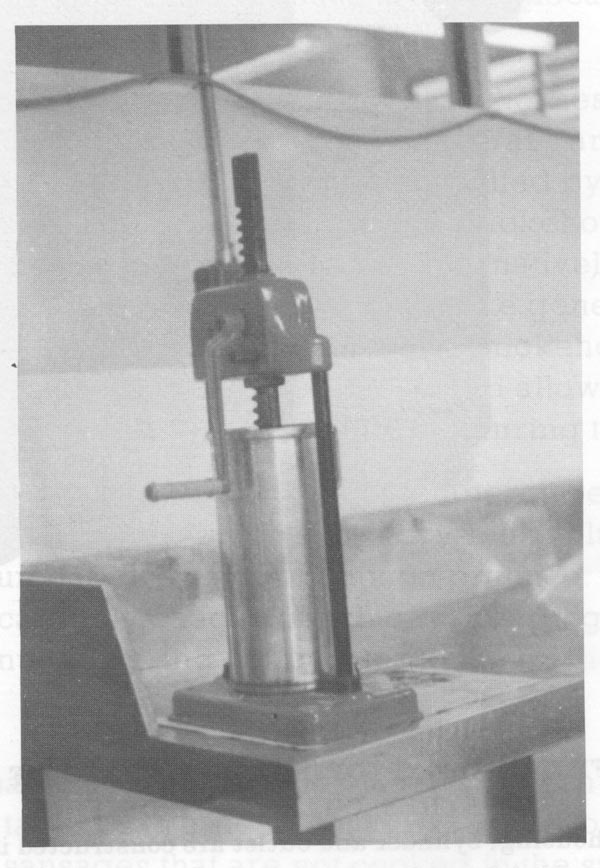
Fig. 11 HAND STUFFER
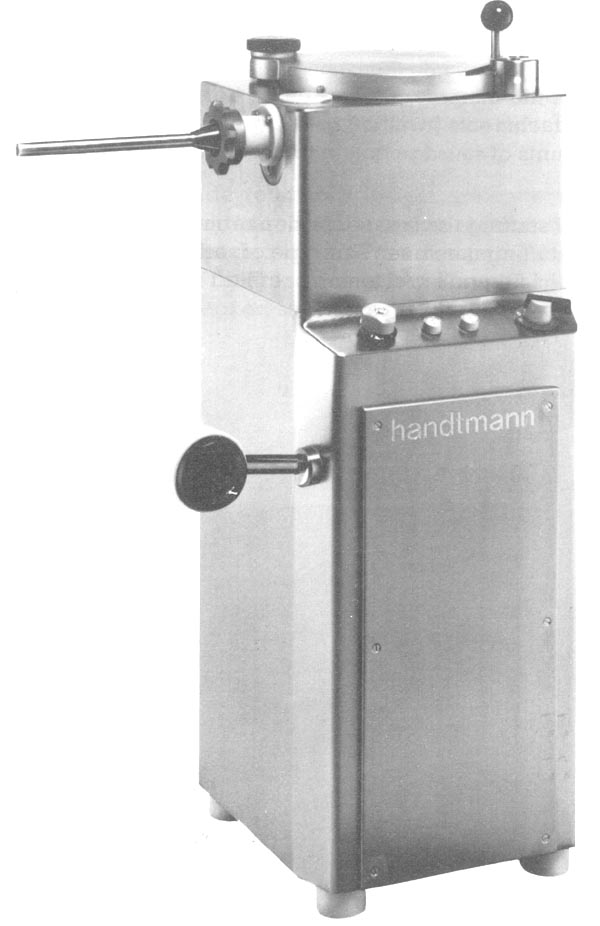
Fig. 12 PISTON FILLER F 30 S-TOP FOR ALL TYPES OF SAUSAGES. WHETHER COARSE-CUT OR FINE.
The machine housing, cylinder and outlet are constructed in stainless steel;
filling pressure is provided from a trouble-free hydraulic pump; barrel capacity 30 litres.
(Photo courtesy of Albert Handtmann, GmbH & Co KG,
D-7950 Biberach/Riss 1, W. Germany)
Linking of filled casings by hand is done on a stuffing table; this manual operation is particularly practised for large diameter sausages. Semiautomatic clipping machines are also available to close the end of large diameter sausages.
Linking machines tie the stuffed small-and medium-diameter casings (with thread or twist) into units of desired uniform length; this method greatly reduces the labour cost when the size of operation justifies its use. Machines that stuff and link are today the accepted practice in medium- and large-scale production. After the sausages have been linked, they are placed on rods which are hung either on racks or cages suspended from overhead rails or upon trucks.
There are two basic types of smokehouse: the simple or natural-air-circulating smokehouse and the modern or air-conditioned smokehouse. The design of a smokehouse has a great influence an obtaining uniform results.
The natural draught smokehouses are made of brick, hollow tile and stone or they are of metal construction; also they can be improvised with other materials. Walls are, if possible, insulated and coated with a smooth surface of enamel. The fireplace can be located either outside or directly inside the smokehouse at one end. In any case, the circulation should be so directed that the smoke is uniformly distributed throughout the chamber. A false ceiling is built 65–90 cm below the roof and is sloped to allows several openings for the escape of smoke. Such a construction eliminates condensation. The roof of the building is insulated and is provided with one ventilator for venting the smoke into the atmosphere. The ventilator is equipped with a damper for controlling the amount of draught. This type of smokehouse is usually located in a separate building.
Modern or air-conditioned (forced ventilation) smokehouses are equipped not only to smoke but also to cook and chill the sausages. Their walls are usually fully insulated. Air circulation is created by fans and humidity is controlled by steam injectors or by varying the amount of outside air introduced into the smokehouse. Air temperature is maintained by a series of connected gas-heated or alternatively heated pipes. With this type of smokehouse, especially designed sawdust smoke generators are extensively used. The generated smoke is drawn by a fan into the smokehouse. The use of generators facilitates control of the density of smoke and allows the elimination by washing of soot and other undesired particles formed during the combustion process.
Special attention must be given to the control of temperature and humidity in the smokehouse. In this respect wet-bulb (black) and dry-bulb (blue) thermometers are often used but other instruments are also in common practice. Records of these thermometers should be carefully checked each day. Keeping the smokehouse clean does much toward preventing fire and contributes to the quality and shelf life of sausages.
Cooking of sausages, particularly the large kind can be done by submerging them in hot water in steel tanks or in a steam-jacketed round-bottomed kettle. To avoid heat loss and shrivelling, sausages that are not cooked in the smokehouse should be moved immediately after smoking to the cooker. Another method, used for small-diameter sausages, is cooking in special cooking cabinets; after cooking, sprays of cold water chill them to an internal temperature slightly above room temperature.
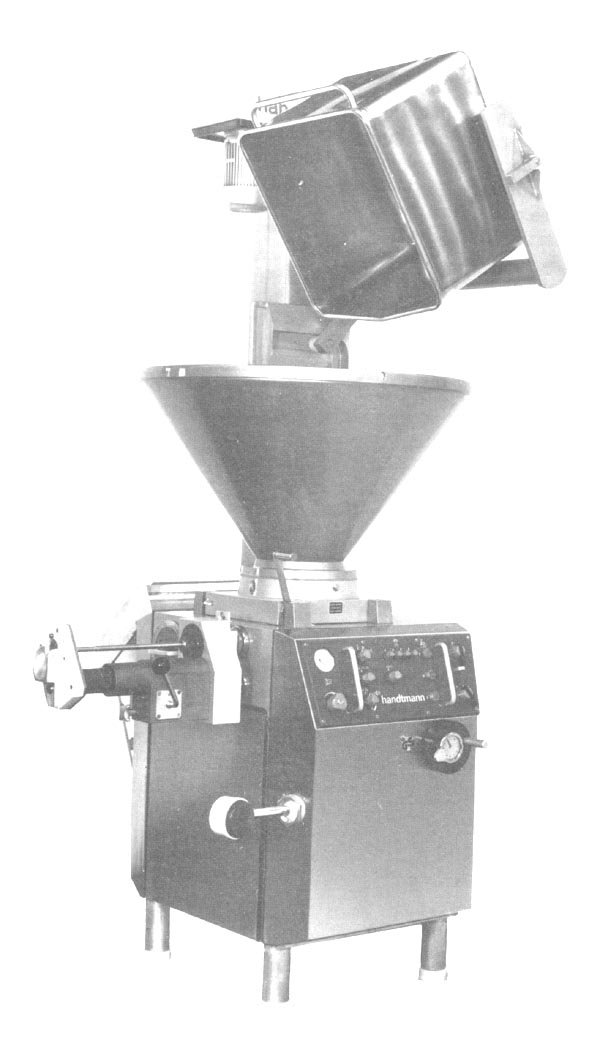
Fig.13VACUUM FILLER VF 12–200.
Machine for fast portioning and linking of sausages, jars, cans and containers
in exact portions; 200-, 150- and 100-litres hopper; lifting device.
(Photo courtesy of Albert Handtmann, GmbH & Co KG,
D-7950 Biberach/Riss 1, W. Germany)
After cooking, the cage on which the sausages are hung is removed. The remaining heat is normally sufficient to dry the sausages prior to their placement in the chiller at 2–8°C.
Tanks for cooking raw materials or sausages in water are usually square and of a convenient size and depth for loading and unloading. The choice of the type of cooking tank should be in line with the given capacity, raw material available and type of final product.
The sausage plant must be provided with a collection of different hand tools, such as various types of knives, cleavers, sharpening steel, knife racks, metal or wooden smoke rods, thermometers to register temperature of meat during chilling or cooking, plastic chopping blocks and cutting tables, motor-driven chopping block cleaner, semiautomatic price indicating scale, clip machine for large calibre sausages etc.
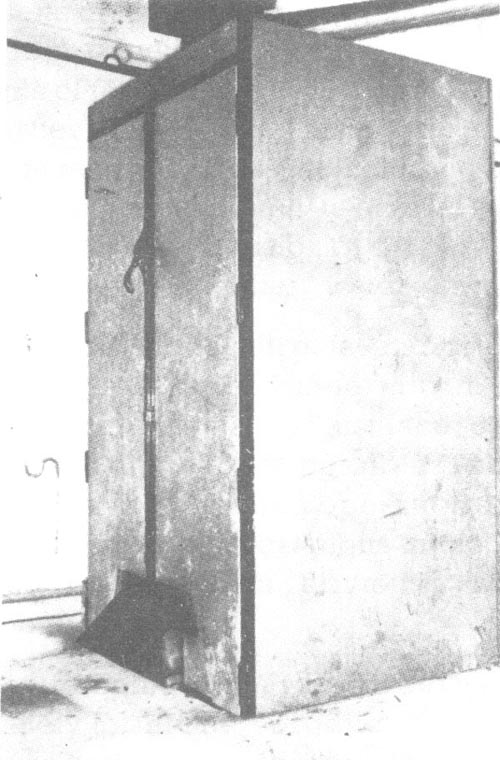 | 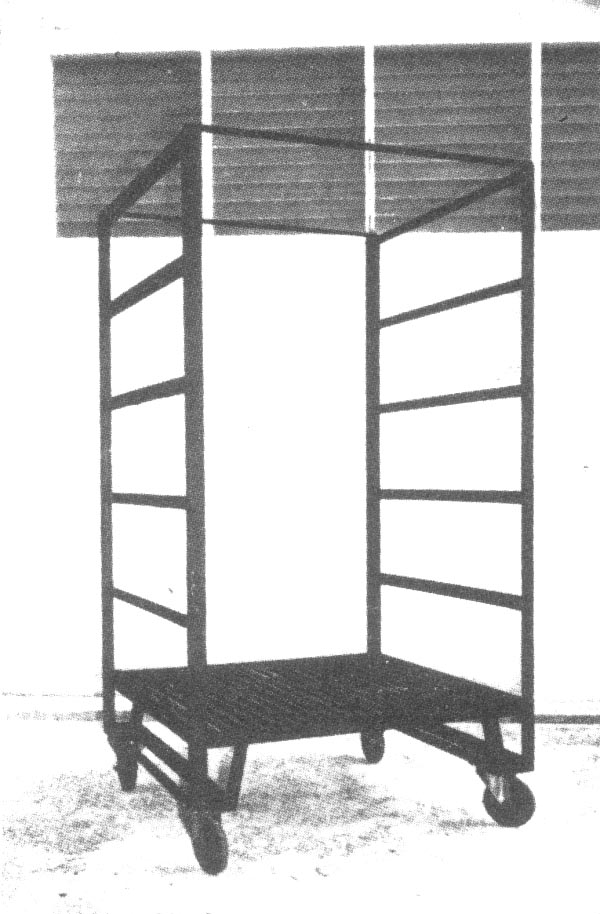 | |
| Fig.14 A SIMPLE SMOKEHOUSE | Fig.15 SMOKING TROLLEY FOR THE SMOKEHOUSE |